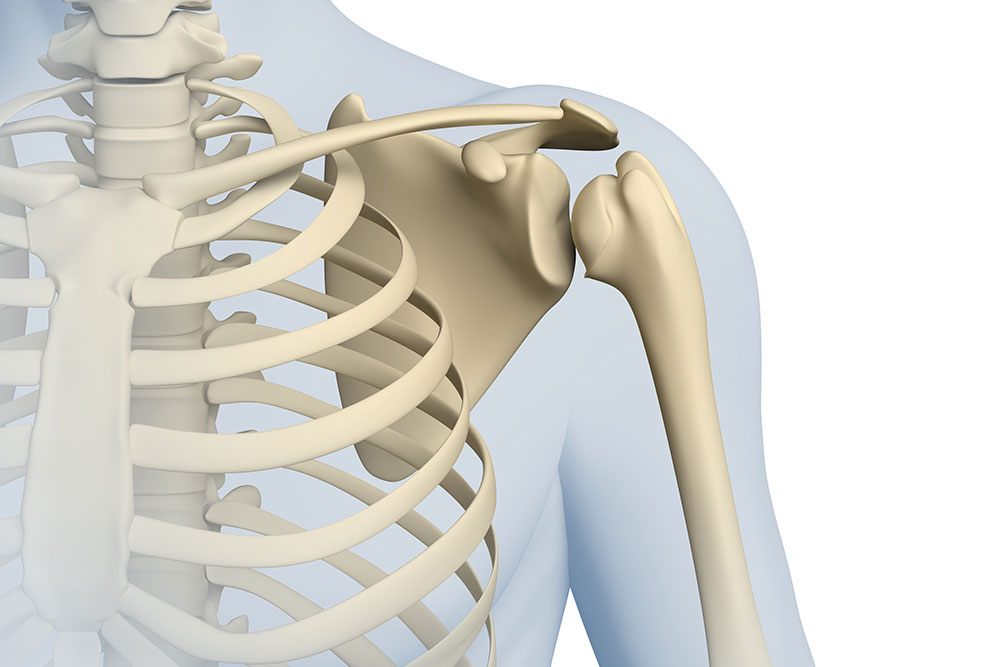
Richard Cuningham, MD, a board certified orthopedic surgeon and sports medicine specialist, has a clinical focus on treatment of a variety of shoulder conditions. Dr. Cunningham’s expert care includes glenoid bone loss treatment. Glenoid bone loss typically occurs as a result of recurrent shoulder dislocations. Glenoid bone loss is challenging to accurately diagnose and treat. Dr. Cunningham is high-trained at developing a targeted care plan to treat glenoid bone loss in conjunction with treating chronic shoulder instability, or shoulder dislocations. Patients rely on Dr. Cunningham’s experience to address these collateral chronic shoulder conditions, and improve overall shoulder health.
What is Glenoid Bone Loss?
The shoulder joint or glenohumeral joint is made up of the the head of the humerus (upper arm bone) and the socket or glenoid. The glenoid is part of the scapula (shoulder blade). The ends of the ball and socket are lined with coating cartilage or articular cartilage. A fibrocartilage gasket like structure called the glenoid labrum lines the edge of the glenoid socket. When someone dislocates their shoulder, the ball forcefully comes out of the socket and tears the labrum away. However, in addition to tearing the labrum away, the ball can chip the edge of the glenoid leading to glenoid bone loss. This further destabilizes the shoulder making it much more likely for patients to dislocate again in the future. The cartilage on the edge of the socket is also damaged when the bone on the edge of the socket breaks away. Patients with glenoid bone loss report shoulder instability, pain, weakness, and difficulty with daily activities, overhead movement, and lifting heavy objects.
Glenoid Bone Loss: Chronic Shoulder Instability and Dislocation Factors
Patients who have dislocated their shoulder typically tear their labrum and may also damage the bone on the edge of the glenoid. Patients often recover but then go on to have another shoulder dislocation which causes further damage to the labrum and bone. Over time, the shoulder dislocates more and more easily and simple things such as putting a coat on or reaching out for an object become problematic. Patients often see Dr. Cunningham when their simple activities of daily living become problematic.
Diagnosis and Nonsurgical Treatment
Dr. Cunningham provides a comprehensive diagnosis for patients experiencing shoulder symptoms. Glenoid bone loss is identified with a physical exam and imaging studies, such as an X-ray, CT scan, and MRI. Critical to a successful glenoid bone loss treatment is a precise understanding of the location and degree of bone damage. Dr. Cunningham provides an accurate diagnosis and treatment plan, depending on his findings. Glenoid bone loss treatment can be an essential component of chronic shoulder dislocation treatment.
Dr. Cunningham often prescribes nonsurgical treatment for first time shoulder dislocations. This can involve:
- Assistive support: sling to support the shoulder and limit movement
- Pain management: medication and ice for inflammation and pain
- Modified activity: restricting overhead activities, repetitive shoulder movement, and heavy lifting
- Physical therapy: gentle exercise to improve strength, range of motion, stability, and posture
- Time: patience, in some cases several months
Surgical Treatment
Patients that have recurrent shoulder dislocations that limit their ability to resume their activities or their work often require surgery.
Arthroscopic Bankart Repair – Patients who have repeatedly dislocated their shoulder and who have torn their glenoid labrum but do not have any glenoid bone loss usually require an arthroscopic procedure where the labrum is repaired back to the edge of the socket using several small all suture anchors. The anchor is placed on the edge of the socket and off of the anchor come strong sutures which are then passed through the labrum so that the labrum can be reattached to the edge of the glenoid socket.
Arthroscopic Remplissage Procedure – When patients dislocate their shoulder, they often sustain an impaction fracture to the back of the humeral head in addition to tearing their labrum. This impaction fracture is called a Hill Sachs defect. Often, in addition to performing an arthroscopic Bankart repair to address the torn labrum, Dr. Cunningham also performs a remplissage procedure for added shoulder stability. In this procedure, an adjacent rotator cuff tendon is sewn into the Hill Sachs defect thus filling this hole in the bone and making it much less likely that one will dislocate their shoulder again.
Latarjet Procedure – In the case of both labral tearing and glenoid bone loss of more than 20%, this procedure is often required. In this procedure, a piece of a nearby shoulder bone called the coracoid, is mobilized and secured to the edge of the socket to restore the normal size to the socket which then stabilizes the shoulder. An alternative to using a portion of the patient’s coracoid is to use a piece of donor bone to restore the normal size to the damaged shoulder socket.
The shoulder is a complex joint. It is vulnerable to dislocations. As such, chronic shoulder dislocations with associated glenoid bone loss are complex surgical procedures requiring an experienced orthopedic surgeon like Dr. Cunningham. He has successfully returned many chronic shoulder condition patients to an active life. Request a consultation with Dr. Cunningham today. In Vail, CO (970) 476-2451, in Frisco (970) 668-3633, and Edwards (970) 569-3240.
